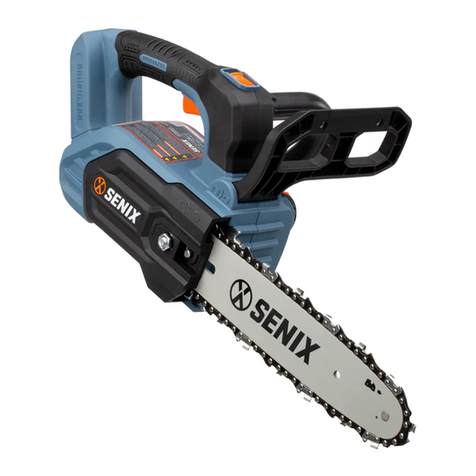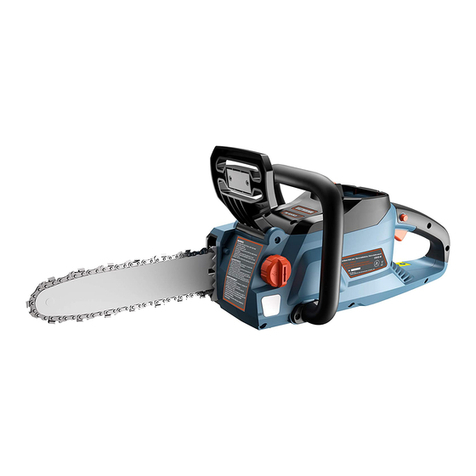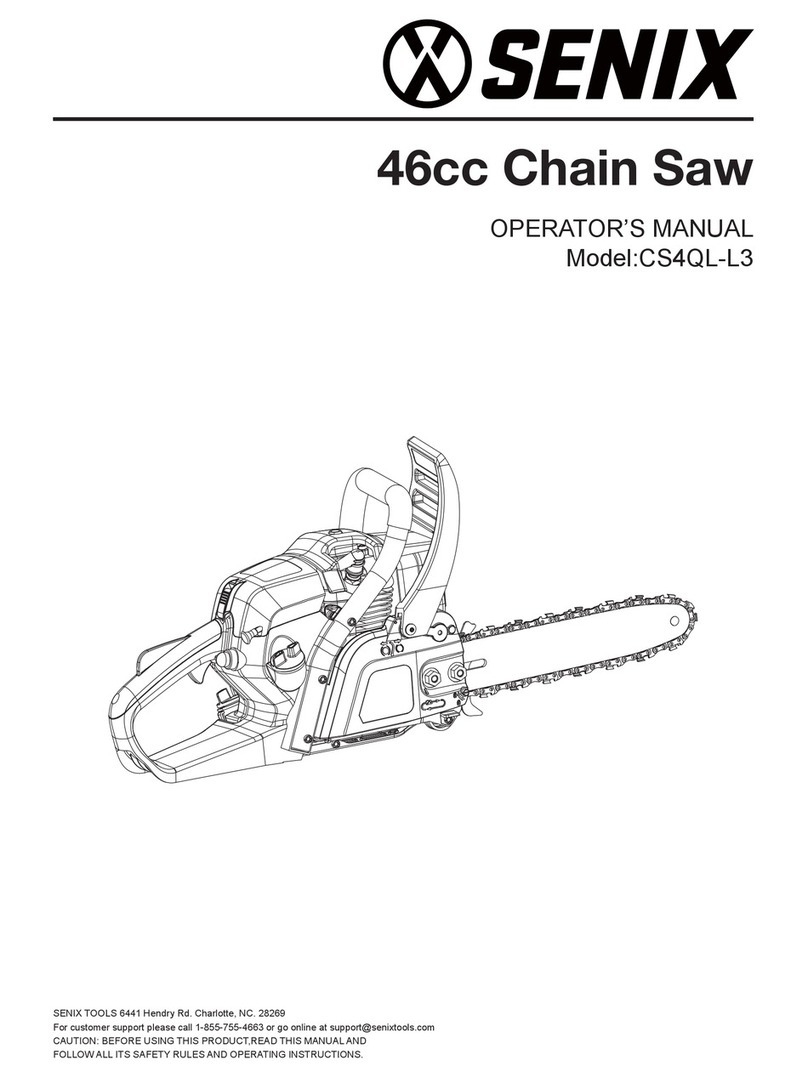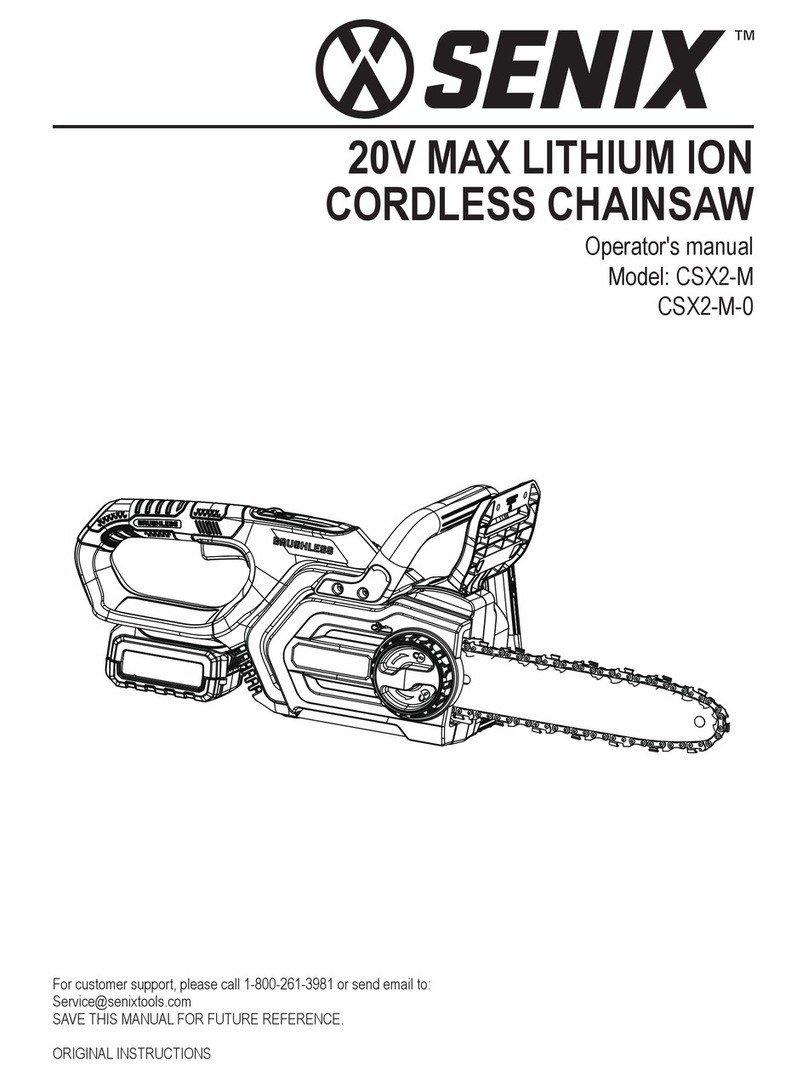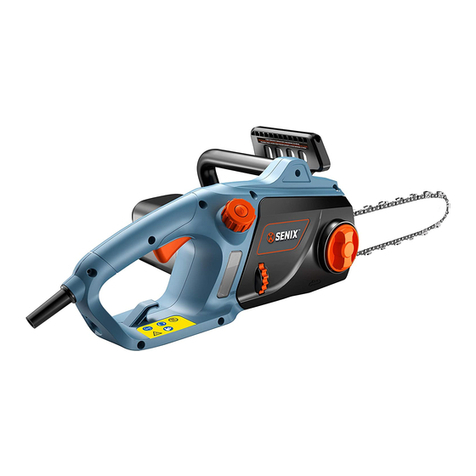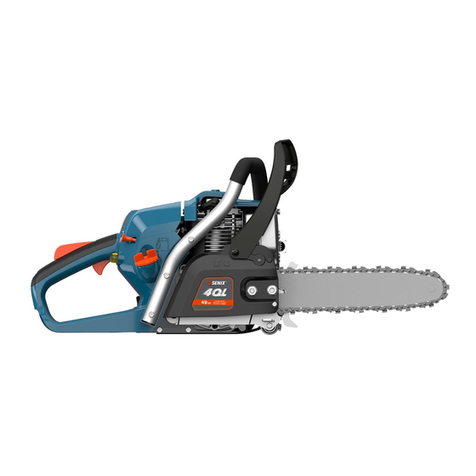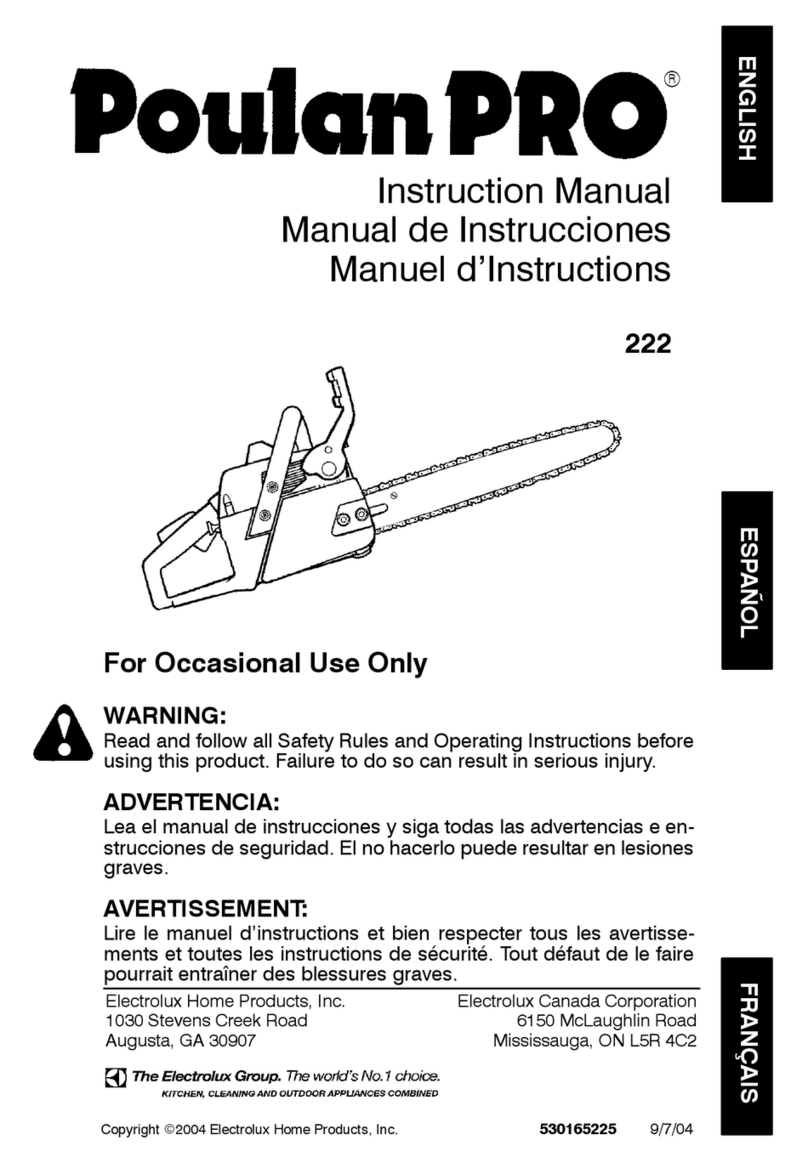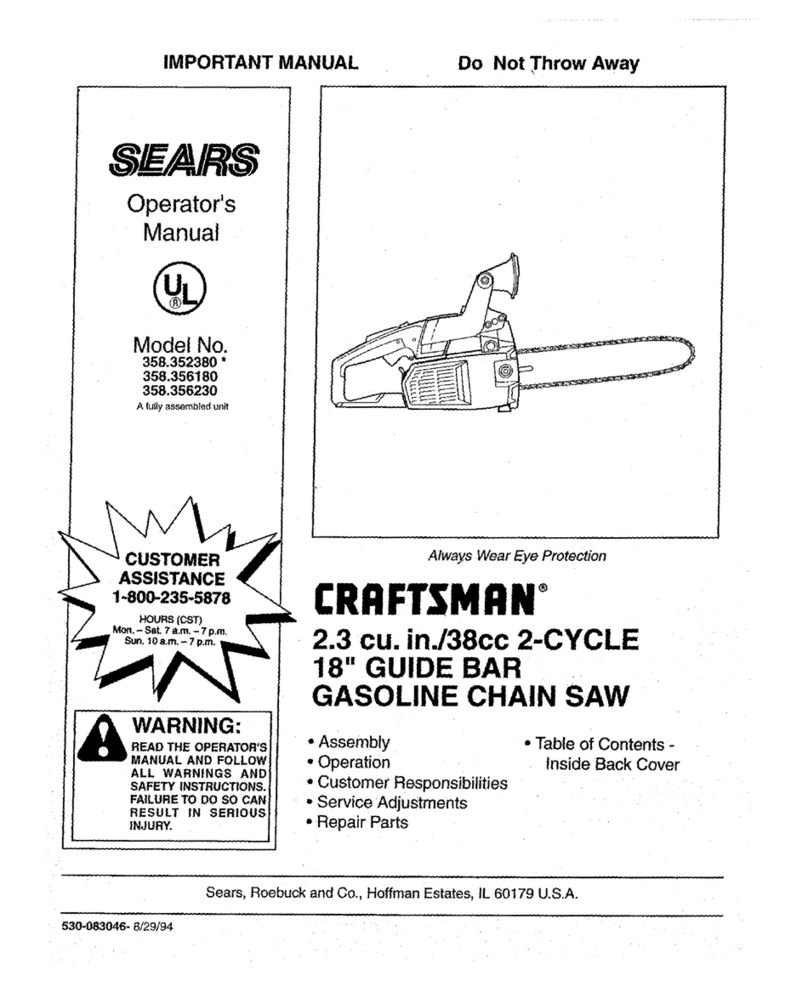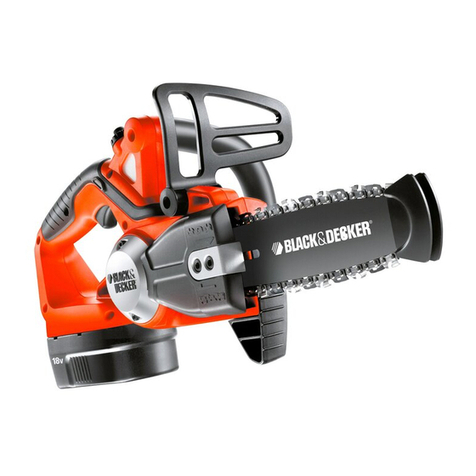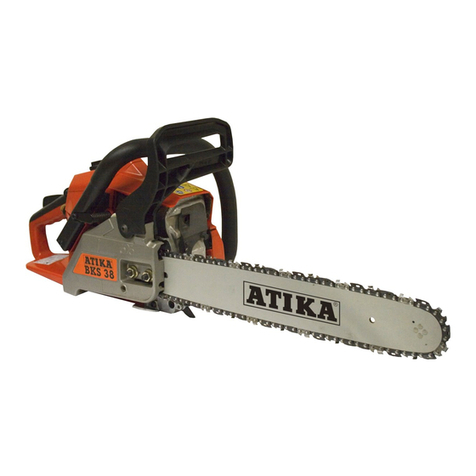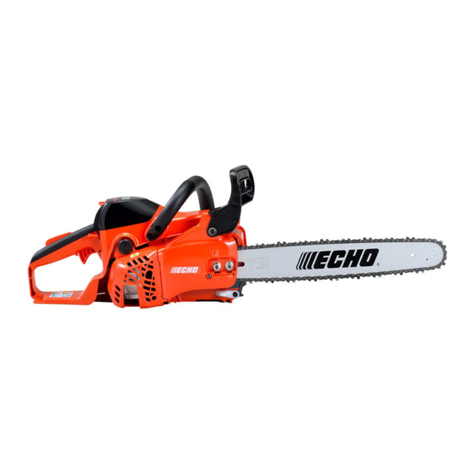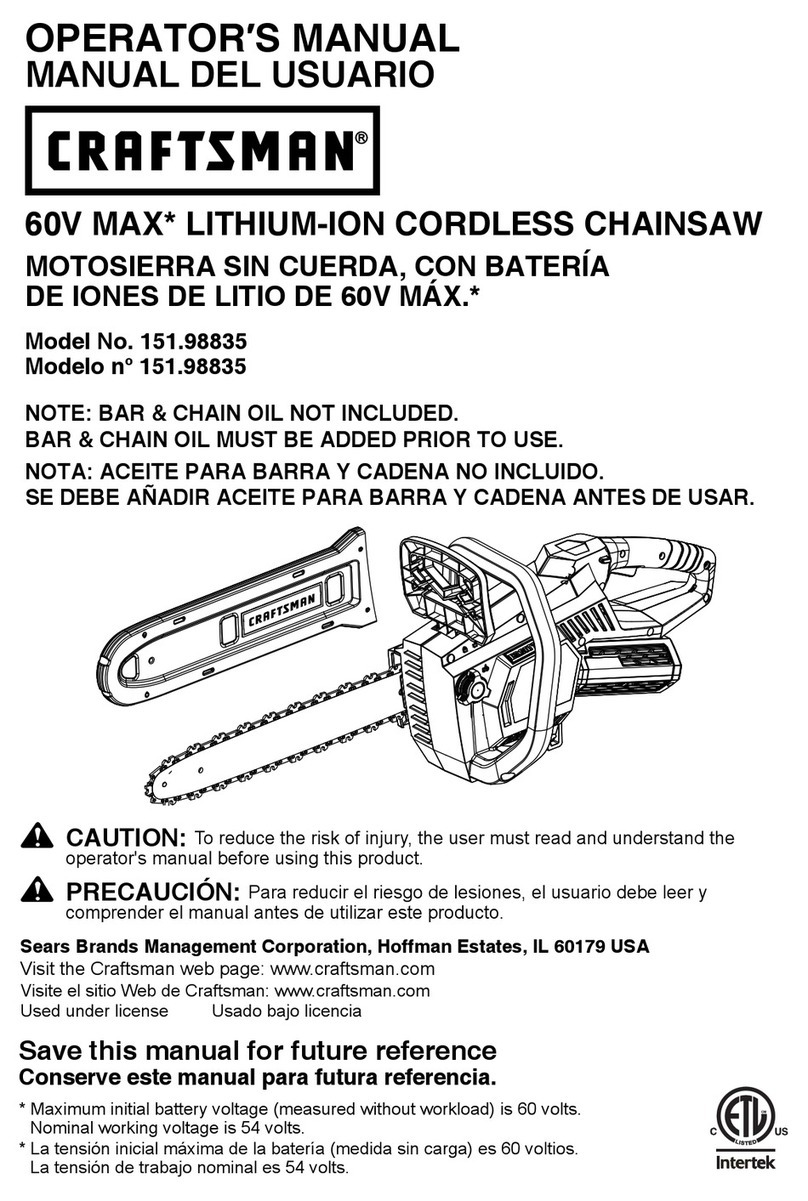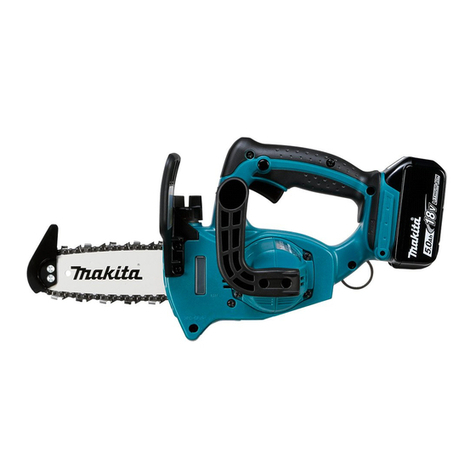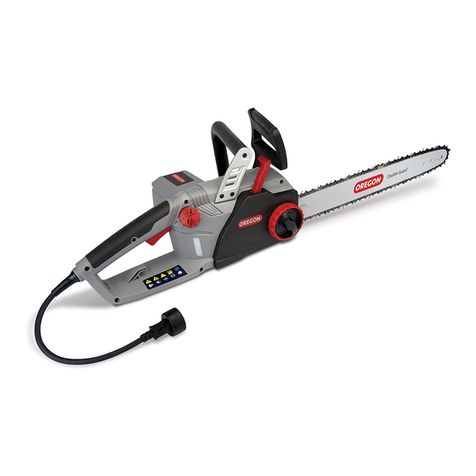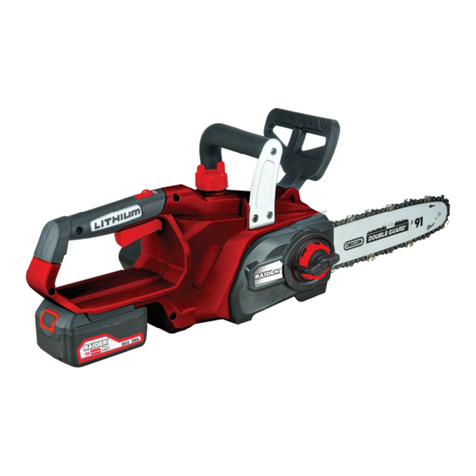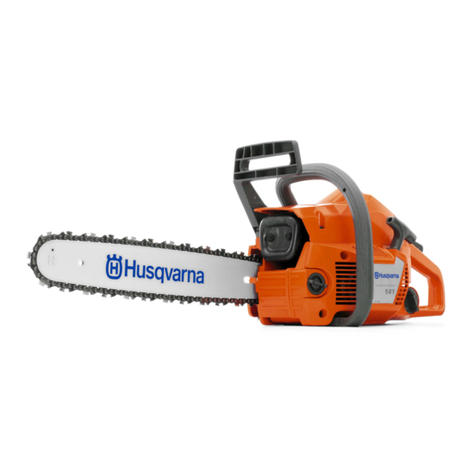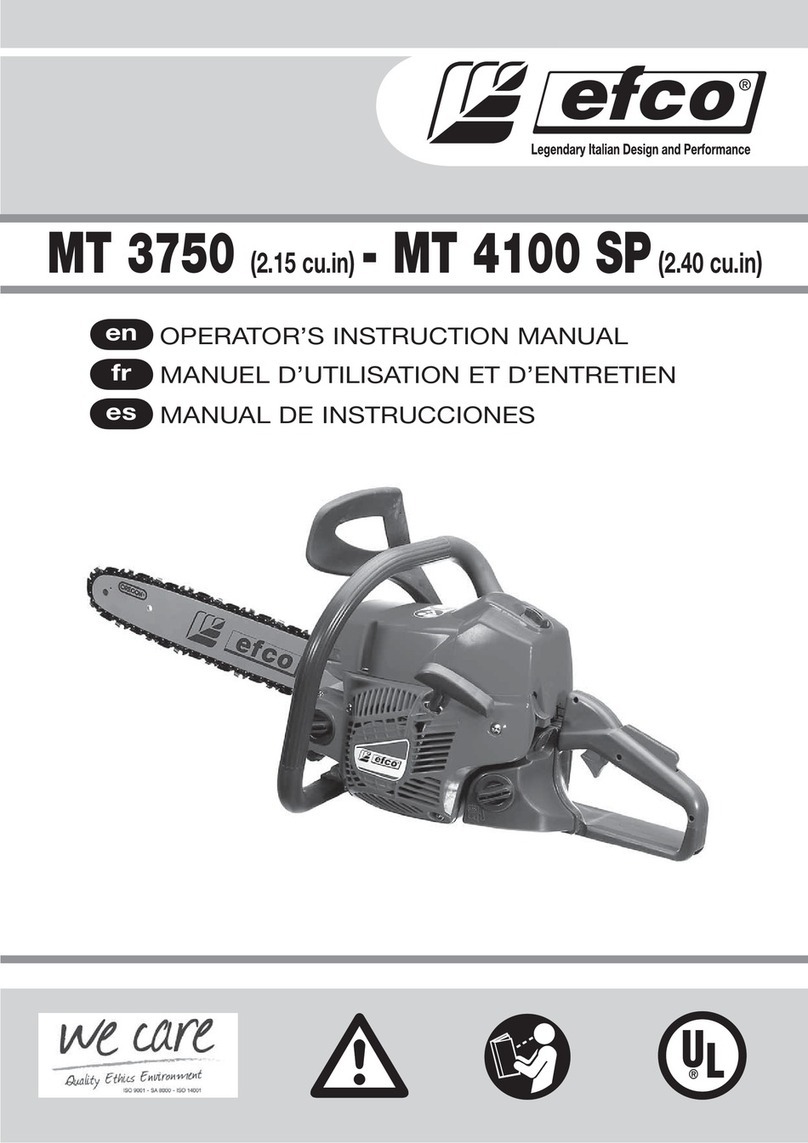Senix CSX5-M User manual

58V MAX LITHIUM ION
CORDLESS CHAINSAW
Operator’s manual
Model: CSX5-M
For customer support, please call 1-800-261-3981 or send email to:
SAVE THIS MANUAL FOR FUTURE REFERENCE.

1WWW.SENIXTOOLS.COM
TECHNICAL DATA
TABLE OF CONTENTS TECHNICAL DATA
Model Number: CSX5-M
Motor: 40V Brushless Motor
Max. Motor Speed: 8200 RPM (No Load)
Max. Chain Speed: 49 FPS (Feet Per Second)
Oil Tank Capacity: XX oz.
Saw Chain: 16 inch, Oregon
Saw Chain Model: 91PJ056X
Guide Bar Model: 160SDEA041
Battery/Charger: B25X5/CHX5
Battery: 58V Max Lithium Ion, 2.5 Ah
Weight (w/Battery): 12 lbs.
Product Dimensions: 32 x 8.5 x 10 in.
TECHNICAL DATA���������������������������������������������������������������������������������������������1
SAFETY
SPECIFIC RULES FOR CHAINSAWS��������������������������������������������������������������3
SAWING TECHNIQUES
FELLING A TREE ���������������������������������������������������������������������������������������������� 4
FELLING BACK A CUT��������������������������������������������������������������������������������������5
LIMBING A TREE ����������������������������������������������������������������������������������������������5
BUCKING A LOG�����������������������������������������������������������������������������������������������5
COMPONENT LOCATION
KNOW YOUR CHAINSAW�������������������������������������������������������������������������������� 7
ASSEMBLY
ASSEMBLY OF GUIDE BAR AND SAW CHAIN �����������������������������������������������8
ADJUSTMENTS
TENSIONING THE CHAIN ��������������������������������������������������������������������������������9
OPERATION
ATTACH/REMOVE THE BATTERY����������������������������������������������������������������� 10
PREPARATION������������������������������������������������������������������������������������������������10
DURING OPERATION�������������������������������������������������������������������������������������10
SAFETY WARNINGS ��������������������������������������������������������������������������������������10
ON/OFF SWITCH��������������������������������������������������������������������������������������������10
MAINTENANCE
CLEANING ������������������������������������������������������������������������������������������������������ 11
REPLACING THE CHAIN�������������������������������������������������������������������������������� 11
FILLING THE AUTO OIL SYSTEM������������������������������������������������������������������ 11
STORAGE ������������������������������������������������������������������������������������������������������� 11
PARTS
EXPLODED VIEW�������������������������������������������������������������������������������������������12
WARRANTY
LIMITED TWO-YEAR WARRANTY�����������������������������������������������������������������14

2 WWW.SENIXTOOLS.COM
SAFETY
SAFETY
Safety is a combination of common sense, staying alert
and knowing how your item works. SAVE THESE
SAFETY INSTRUCTIONS.
WARNING — To reduce the risk of injury, user must
read and understand operator’s manual.
WARNING — Do not cut down trees in high wind
conditions. This can result in injury
and should only be performed by a
trained professional.
1. READ and become familiar with this entire instruction
manual. LEARN the tool’s applications, limitations, and
possible hazards.
2. AVOID DANGEROUS CONDITIONS. Do not use in wet
or damp areas or expose them to rain. Keep work areas
well lit.
3. DO NOT use in the presence of ammable liquids
or gases.
4. DO NOT direct the tool at any bystanders.
5. KEEP BYSTANDERS AT A SAFE DISTANCE from the
work area, especially when the tool is operating. NEVER
allow children or pets near the tool.
6. DO NOT FORCE THE TOOL to do a job for which it was
not designed.
7. DRESS FOR SAFETY. Do not wear loose clothing,
gloves, neckties, or jewelry (rings, watches, etc.) when
operating the tool. Inappropriate clothing and items can
get caught in moving parts and draw you in. ALWAYS
wear non-slip footwear and tie back long hair.
8. WEAR A FACE MASK OR DUST MASK if working in
dusty or dirty conditions.
9. ALWAYS remove the battery from the tool when making
adjustments, changing parts, cleaning, or working on
the tool.
10. AVOID ACCIDENTAL START-UPS. Make sure the
power switch is in the OFF position before inserting
the battery.
11. REMOVE ADJUSTMENT TOOLS. Always make sure
all adjustment tools are removed from the tool before
turning it on.
12. NEVER LEAVE A RUNNING TOOL UNATTENDED.
Turn the power switch OFF. Do not leave the tool until it
has come to a complete stop.
13. NEVER STAND ON A TOOL. Serious injury could
result if the tool tips or is accidentally hit. DO NOT store
anything above or near the tool.
14. DO NOT OVERREACH and DO NOT cut above
shoulder height. This helps prevent unintended tip
contact and enables better control of the chain saw in
unexpected situations.
15. Keep proper footing and balance at all times. Wear oil-
resistant rubber-soled footwear. Keep the oor clear of
oil, scrap, and
other debris.
16. WEAR NECESSARY hand and hearing protection.
Wear no-slip heavy duty work gloves and hearing
protectionin order to prevent injury.
17. MAINTAIN TOOLS PROPERLY. ALWAYS keep tools
clean and in good working order. Follow instructions for
lubricating and changing accessories.
18. CHECK FOR DAMAGED PARTS. Check for alignment
of moving parts, jamming, breakage, improper
mounting, or any other conditions that may aect the
tool’s operation. Any part that is damaged should be
properly repaired or replaced before use.
19. DO NOT operate the tool if you are under the inuence
of drugs, alcohol, or medication that may aect your
ability to properly use the tool.
20. USE SAFETY GOGGLES AT ALL TIMES that comply
with ANSI Z87.1. Normal safety glasses only have
impact resistant lenses and are not designed for safety.
Wear a face or dust mask when working in a
dusty environment.
21. Use ear protection such as plugs or mus during
extended periods of operation.
!
!

3WWW.SENIXTOOLS.COM
SAFETY
SPECIFIC RULES FOR CHAINSAWS
WARNING — Do not let comfort or familiarity with
product (gained from repeated use)
replace strict adherence to product
safety rules. If you use this tool
incorrectly, you can suer serious
personal injury!
WARNING — Do not cut down trees in high wind
conditions. This can result in injury
and should only be performed by a
trained professional.
1. Keep all parts of the body away from the saw chain
when the chainsaw is operating. Before you start the
chainsaw, make sure the saw chain is not
contacting anything.
2. Always hold the chainsaw with your right hand on the
rear handle and your left hand on the front handle.
Holding the chainsaw in the opposite manner can result
in an increased risk of serious injury to the user.
3. Only hold the power tool by the insulated gripping
surfaces to avoid electric shock in case the saw chain
contacts hidden wiring. Saw chains contacting a live
wire may make exposed metal parts of the power tool
live and can give the operator an electric shock.
4. Keep the saw chain away from any cords or
extension cables.
5. Wear safety glasses and hearing protection. Protective
equipment for hands, legs, head and feet is also highly
recommended. Protective clothing greatly reduces the
risk of personal injury from loose debris or accidental
contact with the saw chain.
6. Do not operate the chainsaw while standing in a tree.
Only operate the chainsaw from a rm, level surface
xed on the ground. Always keep proper footing during
operation. Slippery or unstable surfaces such as ladders
may cause a loss of balance or control.
7. When cutting a limb that is under tension, be alert
for spring back. When tension from wood bers and
branches is suddenly released, the limb may y in
unpredictable ways, possibly resulting in kickback and
injury to the user.
8. Use extreme caution when cutting brush and saplings.
The slender material may catch the saw chain, whipping
towards you or pulling you o balance.
9. Carry the chainsaw by the front handle with the
chainsaw switched o and away from your body. When
transporting or storing the chainsaw always protect the
blade with a scabbard (blade cover). Remove the battery
for transport.Routinely lubricate, adjust chain tension,
and check blades for dullness. Follow these instructions
closely to minimize kickback and maximize the lifespan
of the tool.
10. Keep handles dry, clean and free of oil and grease.
Slippery handles increase the chances of
losing control.
11. Only use this chainsaw to cut wood. Do not cut plastic,
masonry or other non-wood materials. Do not use this
chainsaw for anything other than its intended purpose.
Let the saw work at its own pace.
REDUCING KICKBACK
Kickback can occur when the tip of the guide bar touches
an object or when the wood closes in and pinches the saw
chain inside of the cut. Tip contact can kick the guide bar
up and back towards the operator.
WARNING — The danger of a kickback is greatest
when attempting to cut near or with the
guide bar tip. Always apply the saw as
atly as possible in order avoid a loss of
control during operation.
Pinching the saw chain along the top of the guide bar can
push the bar rapidly towards the operator. Either of these
reactions may cause a loss in control of the chainsaw,
increasing the chances of serious personal injury. Do not
rely on the safety devices built into the saw.
Kickback is the result of tool misuse and/or incorrect
operating procedures. These conditions can be minimized
with the following steps:
1. Maintain a rm grip, with thumbs and ngers encircling
the chainsaw handles. Both hands should be on the saw
with your body and arms in a position to resist
kickback forces.
2. Do not overreach and do not cut above shoulder height.
Keep the work area free from obstructions.
3. Only use replacement bars and chains specied by
Senix. Replace dull blades as necessary.
4. Do not let the tip of the guide bar contact any surfaces.
5. Keep proper tension on the blade at all times. Check the
tension at regular intervals. Remove the battery from the
tool before making any adjustments to the blade or
the tool.
!
!
!

4 WWW.SENIXTOOLS.COM
SAWING TECHNIQUES
6. Cuts should only take place while the chain is moving
at full speed. Do not turn the saw ON or OFF in the
middle of a cut. Use extreme caution when re-entering
a previous cut.Cut one log at a time. Do not attempt
plunge or bore cuts. Watch for shifting logs or other
external forces that could close a cut and pinch the
chain.
7. Make a precut on the opposite side of the log to avoid
the blade from being pinched during operation as
another safeguard against kickback.
SAWING TECHNIQUES
• Saw o the lower branches on the tree rst. By doing
so, it is easier for the cut branches to fall to the ground.
• At the end of the cut, the weight of the saw suddenly
increases for the user since it is no longer being
supported by a branch. There is a risk of losing control
of the saw, so make sure to stay alert during the entire
sawing operation.
• Only pull the saw out of a cut while the saw is running.
By doing so, you prevent the chain from jamming in
the wood.
• Do not saw with the tip of the guide bar. Do not saw
into the branch formations (where the tree branches
outwards). This will impede the tree’s ability to heal.
• For sawing o smaller branches, place the stop face
of the saw on the branch. This prevents unwanted
movements of the saw at the beginning of the cut. While
applying light pressure, guide the saw through the
branch from top to bottom.
• For sawing o larger branches, rst make a relief cut.
Saw through 1/3 of the branch diameter from the bottom
to top using the top side of the guide bar. Then saw from
top to bottom for the other 2/3 using the bottom side of
the guide bar. Saw o longer branches in sections in
order to maintain control over the location of impact.
FELLING A TREE
When bucking and felling operations are being performed
by two or more persons at the same time, the felling
operations should be separated from the bucking operation
by a distance of at least twice the height of the tree
being felled.
Trees should not be felled in a manner that would
endanger any person, strike any utility line or cause any
property damage. If the tree does make contact with any
utility line, the company should be notied immediately.
The chain saw operator should keep on the uphill side of
the terrain as the tree is likely to roll or slide downhill after it
is felled.
An escape path should be planned and cleared as
necessary before cuts are started. The escape path should
extend back and diagonally to the rear of the expected line
of fall (Figure 1).
Danger zone
Escape
route Escape
route
Description of felling: escape routes
Felling direction
Danger zone
Figure 1 - Escape routes
Before felling is started, consider the natural lean of the
tree, the location of larger branches and the wind direction
to judge which way the tree will fall. Remove dirt, stones,
loose bark, nails, staples and wire from the tree.
Make the notch 1/3 the diameter of the tree, perpendicular
to the direction of falls (Figure 2).
Direction of fall
Notch
50 mm Felling back cut
Hinge
Description of felling: undercutting
50 mm
Figure 2 - Notching undercut
Make the lower horizontal notching cut rst. This will help
to avoid pinching either the saw chain or the guide bar
when the second notch is being made.

5WWW.SENIXTOOLS.COM
SAWING TECHNIQUES
FELLING BACK A CUT
Make the felling back cut at least 50 mm higher than the
horizontal notching cut (Figure 2). Keep the felling back cut
parallel to the horizontal notching cut. Make the felling back
cut so enough wood is left to act as a hinge. The hinge
wood keeps the tree from twisting and falling in the wrong
direction. Do not cut through the hinge.
As the felling gets close to the hinge, the tree should begin
to fall. If there is any chance that the tree may not fall in
desired direction or it may rock back and bind the saw
chain, stop cutting before the felling back cut is complete
and use wedges of wood, plastic or aluminium to open the
cut and drop the tree along the desired line of fall.
When the tree begins to fall remove the chain saw from the
cut, stop the motor, put the chain saw down, then use the
retreat path planned. Be alert for overhead limbs falling and
watch your footing.
LIMBING A TREE
Limbing is removing the branches from a fallen tree. When
limbing leave larger lower limbs to support the log o the
ground. Remove the small limbs in one cut (Figure 3).
Branches under tension should be cut from the bottom up
to avoid binding the chain saw.
Keep work off ground. Leave support limbs until log is cut.
Limb cut
Tree limbing
Figure 3 - Tree limbing
BUCKING A LOG
Bucking is cutting a log into lengths. It is important to
make sure your footing is rm and your weight is evenly
distributed on both feet. When possible, the log should be
raised and supported by the use of limbs, logs or chocks.
Follow the simple directions for easy cutting.
When the log is supported along its entire length, it is cut
from the top (overbuck) (Figure 4).
Log supported along the entire length
Cut from top (overbuck). Avoid cutting earth.
Figure 4 - Log fully supported
When the log is supported on one end, cut 1/3 the diameter
from the underside (underbuck) (Figure 5). Then make the
nished cut by overbucking to meet the rst cut.
2nd cut overbuck (2/3 diameter)
to meet 1st cut (to avoid pinching)
1st cut underbuck
(1/3 diameter)
to avoid splintering
Log supported one end
Figure 5 - Log supported on one end

6 WWW.SENIXTOOLS.COM
SAWING TECHNIQUES
When the log is supported on both ends, cut 1/3 the
diameter from the top (overbuck) (Figure 6). Then make
the nished cut by underbucking the lower 2/3 to meet the
rst cut.
2nd cut underbuck (2/3 diameter)
to meet 1st cut (to avoid pinching)
Log supported both ends
1st cut overbuck (1/3 diameter)
to avoid splintering
Figure 6 - Log supported on both ends
When bucking on a slope always stand on the uphill side of
the log (Figure 7).
Bucking a log
Stand on uphill side when cutting because log may roll
Figure 7 - Stand uphill
To maintain complete control when cutting through a log,
release the cutting pressure near the end of the cut without
relaxing your grip on the chain saw handles. Don’t let the
chain contact the ground. After completing the cut, wait
for the saw chain to stop before you move the chain saw.
Always stop the motor before moving from tree to tree.

7WWW.SENIXTOOLS.COM
COMPONENT LOCATION
COMPONENT LOCATION
KNOW YOUR CHAINSAW
1
2
3
5
56
7
8
9
10
11
4
12
1 — Trigger
2 — Safety Switch1
3 — Battery2
4 — Front handle
5 — Hand guard/Chain break
6 — Oil cap1
7 — Guide bar
8 — Chain
9 — Side cover lock
10 — Side cover
11 — Battery release button
12 — Chain tension wheel
1 On back or underside of chainsaw
2 Battery sold separately

8 WWW.SENIXTOOLS.COM
ASSEMBLY
ASSEMBLY
ASSEMBLY OF GUIDE BAR AND SAW CHAIN
WARNING — Remove the battery before inspecting,
adjusting, performing maintenance, or
cleaning the unit.
CAUTION: Always wear protective gloves when
handling saw chains.
1. Place the saw body on a rm and level surface.
2. Rotate the side cover lock counterclockwise to remove
the cover from the saw’s body (Figure 8).
1
2
Figure 8 - Remove cover
1 — Side cover lock
2 — Cover
3. Wearing protective gloves, wrap the saw chain around
the guide bar, making sure that the teeth are aimed in
the direction of rotation (Figure 9). The chain should be
properly set in the slot running along the entire outside
edge of the guide bar.
Figure 9 - Correct teeth direction
4. Place the saw chain around the sprocket while lining up
the slot in the guide bar with the internal bolt at the base
of the saw and the chain tensioning pin in the guide
bar’s pin hole (Figure 10). The chain tensioning pin may
need adjustment to properly align with the hole in the
guide bar. Use the chain tensioning wheel to adjust its
location until it ts in the guide bar.
1
23
4
Figure 10 - Install chain
1 — Sprocket
2 — Internal bolt
3 — Chain tensioning pin
4 — Chain tensioning wheel
5. Turn the chain tensioning wheel to preliminarily tighten
the guide bar enough that the chain stays in place
(Figure 10). While holding the bar still, reinstall the cover.
Make sure the tab properly line up with the slot on the
body of the saw (Figure 11). Reinstall the side cover lock
and turn it clockwise until it engages. Adjust the
chain tension.
Figure 11 - Reinstall cover
!
!

9WWW.SENIXTOOLS.COM
ADJUSTMENTS
FILLING THE OIL TANK
1. Place the saw on a level surface. Clean the area around
the oil tank cap and then open it.
CAUTION: Make sure that no dirt gets into the oil tank
to prevent clogging in the oil nozzle.
2. Fill the oil tank with XX oz. of saw chain oil (Figure 3).
3. Close the oil tank cap.
ADJUSTMENTS
TENSIONING THE CHAIN
CAUTION: Always wear protective gloves when
handling saw chains.
WARNING — Remove the battery before adjusting the
chain tension.
1. Check the chain tension by pulling the saw chain away
from the guide bar. A properly tensioned chain should
have roughly 1/8 inch (3 mm) of distance between itself
and the bar guide (Figure 12).
Figure 12 - Check chain tension
2. If saw chain tension adjustment is needed, loosen
the side cover lock one full turn and rotate the chain
tensioning wheel (Figure 13). Rotating the wheel
upwards increases the tension. Rotating it downwards
decreases tension. A properly tensioned chain should
have no sag and should only be able to be pulled 1/8
inch (3 mm) away from the guide bar of the
saw (Figure 14).
Figure 13 - Adjust chain tension
Figure 14 - Correct chain tension
IMPORTANT: Do not over-tension the chain: this will
lead to excessive wear and reduces the
life of both the bar and chain.
3. Once the chain is properly tensioned, tighten the side
cover lock.
CAUTION: The saw chain must be tensioned properly
in order to ensure safe operation.
The chain tension is optimal if the saw chain can be lifted
1/8 inch (3 mm) from the center of the guide bar.
Because the saw chain heats up during operation, its
length can uctuate. Check the chain tension every 10
minutes of operation and adjust as necessary, particularly
for new saw chains.
TIP: The saw chain shortens when cooling down. Loosen
the saw chain after work is completed to elongate the
chain’s life and prevent possible damage.
!
!
!
!
!

10 WWW.SENIXTOOLS.COM
OPERATION
OPERATION
WARNING — It is recommendation that rst-time users
should, at minimum, practice cutting
logs on a saw-horse or cradle.
ATTACH /REMOVE THE BATTERY
CAUTION: Only use a Senix-approved battery
and charger.
Note: The battery is not fully charged at the time of
purchase. Charge it fully before using it for the
rst time.
To insert the battery, slide it into the back of the unit until a
“click” is heard. Make sure the battery is fully inserted and
latched into position.
To remove the battery, press the release button and slide
the battery out.
WARNING — Do not insert or remove the battery
while the trigger is pressed or while the
trimmer is in motion.
PREPARATION
Before each use, check the following items to ensure safe
working conditions.
CHAINSAW: Inspect the chainsaw housing, saw chain,
and guide bar for damage. Do not use the chainsaw if
damage has occured.
CHAIN OIL: Check the ll level of the oil tank.
CAUTION: To prevent damage to the chainsaw, never
operate the saw if there is no oil or the oil
level has dropped below the minimum oil
level mark.
SAW CHAIN: Check the chain tension and the condition of
the blades.
TIP: The sharper the saw chain, the easier and more
manageable operations will be.
PROTECTIVE CLOTHING: Wear appropriate close-tting
protective clothing such as protective pants, gloves and
safety shoes. Wear a safety helmet with integrated hearing
protection and a face guard to provide protection against
falling and recoiling branches.
DURING OPERATION
CHAIN OIL: Check the oil level while working. On average,
an oil lling is sucient for approximately 10 minutes of
cutting operation (depending the duration of pauses and
the density of the workpiece).
WARNING — Remove the battery before adjusting the
chain tension.
CHAIN TENSION: Check the saw chain tension every 10
minutes of operation to maximize safety. New saw chains
in particular are subject to changes due to the heat created
by operation. Adjust as necessary to maintain the correct
chain tension.
SAFETY WARNINGS
• In order to ensure safe work, do not operate the saw
above shoulder height.
• Never stand below a branch that is being sawed.
• Exercise caution when sawing both branches under
tension or branches that are splintering.
• Make sure to safe guard against the risk of injury from
falling branches and ying wood projectiles.
• If the machine is in operation, keep persons and animals
away from the danger area.
• The machine is not protected against electric shock
when coming into contact with high-voltage lines.
Maintain a minimum clearance of 30 feet from
current-carrying power lines to avoid life-threatening
electric shock.
• Do not expose the unit to rain.
• When working on an incline, always stand above or to
the side of the branch being sawed.
• Allow the chain to cut for you. Keep the saw running at
full speed for the entire duration of the cut.
!
!
!
!
!

11WWW.SENIXTOOLS.COM
MAINTENANCE
ON/OFF SWITCH
To turn the tool ON: Push the safety button (Figure 15)
and then squeeze the trigger. After the tool has started,
you can release the safety switch without turning the tool
o.
To turn the tool OFF: Release the trigger switch.
12
Figure 15 - Safety and trigger switch
1 — Safety button
2 — Trigger switch
MAINTENANCE
WARNING — Remove the battery before inspecting,
adjusting, performing maintenance, or
cleaning the unit.
CLEANING
• Brush or blow dust and debris out of the air vents using
compressed air or a vacuum. Keep the air vents free of
obstructions, sawdust, and wood chips. Do not spray,
wash, or immerse the air vents in water.
• Wipe o the housing and the plastic components
using a moist, soft cloth. Do not use strong solvents or
detergents on the plastic housing or plastic components.
Certain household cleaners may cause damage or
cause a shock hazard.
• Routinely clean out the dust and debris that gathers
under the tension housing, the oil outlet, and around the
bar and the chain sprocket. Otherwise it can jam up the
sprocket, the chain, and the lubrication system.
REPLACING THE CHAIN
WARNING — Only use replacement bars and chains
specied by the manufacturer. Incorrect
replacement bars and chains may cause
chain breakage and/or kickback.
1. Rotate the side cover lock and remove the cover of the
saw’s body (Figure 8).
CAUTION: Always wear protective gloves when
handling saw chains.
2. Lift the worn saw chain out of the tted slot in the
guide bar.
3. Place the new chain in this position, making sure the
teeth are facing the correct direction and that the edge of
the chain ts into the slot around the guide
bar (Figure 9).
4. Replace the cover and tighten the side cover lock. Adjust
tension before operating.
!
!
!

12 WWW.SENIXTOOLS.COM
PARTS
FILLING THE AUTO OIL SYSTEM
This chainsaw features an auto-oiling system to keep
the chain and guide bar properly lubricated. The oil level
indicator shows the remaining oil in the chainsaw. If the oil
level decreases to below one quarter capacity, rell it with
the proper bar and chain oil. To ll the oil reservoir:
1. Remove the oil cap. Fill the reservoir with bar and chain
oil until the oil level has reached full capacity.
2. Put the oil cap back on. Make sure to check the oil level
after every 10 minutes of use. Unplug the chainsaw
before checking oil levels or lling the oil reservoir.
STORAGE
Examine the unit thoroughly for worn, loose or damaged
parts. If you need to repair or replace a part, contact Senix
customer service at 1-800-261-3981.
• Clean the unit before storing or transporting. Be sure to
secure the unit while transporting.
• Remove the battery from before storing.
WARNING — Shorting the battery terminals together
may cause burns or a re.
• When battery pack is not in use, keep it away from other
metal objects like paper clips, coins, keys, nails, screws,
or other small metal objects that can make a connection
from one terminal to another.
• Store the unit in a clean, dry place. Cover it in order to
provide added protection.
!

13WWW.SENIXTOOLS.COM
PARTS
PARTS
EXPLODED VIEW

14 WWW.SENIXTOOLS.COM
WARRANTY
No. Part # Description Qty.
1Blade Tension Cap Assembly 1
1-1 Tension Lock Knob 1
1-2 Spindle Cover 1
1-3 Bar Cover 1
1-4 Cover Seal 1
2 Chain 1
3 Guide Bar 1
4 Sheath 1
5 Oil Feed Seal 1
6 Screw 22
7 Screw 2
8 Insulating Washer 1
9Tension Adjusting Knob 1
10 Tension Ajustment Rod 1
11 Screw 3
12 Bucking Teeth 1
13 Right Housing 1
14 Screw 4
15 Upper cover 1
16 Brake Handle Assembly 1
16-1 Brake Handle 1
16-2 Guard Plate 1
16-3 Screw 2
17 Oil Outlet Nozzle 1
18 Housing Vent 1
19 Battery Pack Release Spring 1
20 Battery Pack Release Lever 1
21 Lock 1
No. Part # Description Qty.
22 Bake Spring 1
23 Clamp 1
24 Motor 1
25 Shaft 1
26 Spring 1
27 Screw 1
28 Torsion Spring 1
29 Trigger 1
30 Safety Button 1
31 Safety Spring 1
32 PCB 1
33 Oil Tank Assembly 1
33-1 Oil Tank 1
33-2 Filter 1
33-3 Seal 1
33-4 Oil Tube (90) 1
33-5 Spring (60) 1
34 Left Housing 1
35 Handle 1
36 Rubber Washer 1
37 Oil Cap Assembly 1
37-1 Hanger 1
37-2 Seal Ring 1
37-3 Oil Cap 1
38 Oil Tube (120) 1
39 Charger 1
40 4.0Ah Battery 1

15WWW.SENIXTOOLS.COM
WARRANTY
LIMITED TWO-YEAR WARRANTY
Other manuals for CSX5-M
1
Table of contents
Other Senix Chainsaw manuals
